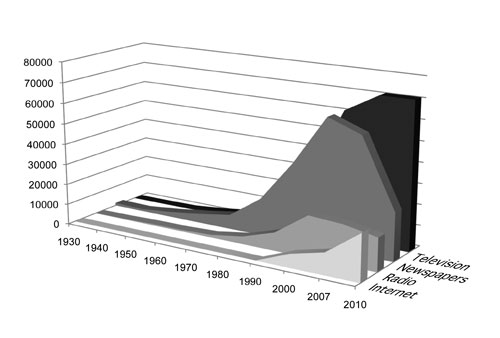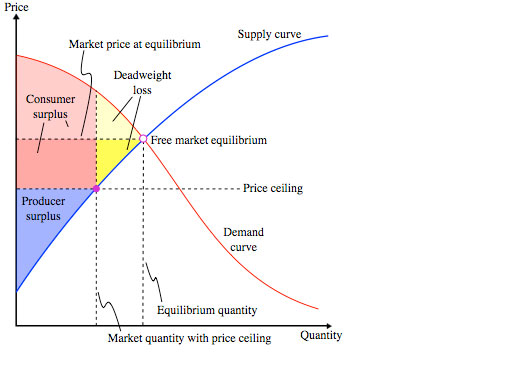By Bill Kovarik
(From Ch. 3 of Revolutions in Communication)
A complex chain of events led to the collapse of the US publishing industry in the early 21st century.
The story begins with a near-monopoly that newspaper publishers enjoyed for over a century. During Golden Age of newspapers, from around 1900 to the 1970s, most dailies were family-owned operations, making five to ten percent annual profits.
The monopoly was initially enforced by rules governing entry into the Associated Press. If an existing newspaper was a member of the AP, it was allowed to veto the membership application of any other start-up newspaper. Naturally, this meant that most towns had only one newspaper with up-to-date national and international news (until E.W. Scripps started United Press in 1907).
AP was forced to stop the veto system after it lost an anti-trust suit (US v AP) in 1945.
Then, in the 1950s and 60s, technological innovation turned the publishing industry on its ear. As economic historian Elizabeth M. Neiva observed:
“The forces that triggered the rapid transformation of the American newspaper industry were not self-serving publishing moguls… but the invention and popularization of a relatively simple new technology — photocomposition.”
Photocomposition (also called “cold” type) replaced cumbersome and expensive Linotype (“hot” type) systems, allowing publishers to cut skilled work forces in half, which greatly accelerating profits. Further savings were achieved with the switch to offset printing, which used lighter, cheaper printing presses. All this greatly enhanced the market value of newspapers, and one consequence was that family newspapers could no longer be kept in the family because the heirs could not afford the estate taxes.
As a result, large family-owned daily newspapers by the hundreds converted to public stock corporations and usually sold to chains like Gannett, Thompson or Knight-Ridder between the 1960s and the 1990s. These public stock corporations were no longer community-based organizations whose primary mission was to serve the public. Instead, Wall Street investors valued their consistent ability to post profits from 20 to 40 percent per year, and insisted on a management style that maximized profit.
The shift in emphasis from public service to profit-making reflected two basic ideas about the modern corporation that were (and still are) contending.
On the one hand, media experts like those on the Hutchins Commission insisted that publishers have a social responsibility. On the other hand, economists like Milton Friedman maintained that the only social responsibility that any corporation really had was to increase its profits. Wall Street preferred Friedman’s view and pushed the publishing industry to keep expanding.
The media monopoly was further consolidated when record-high profits for some newspapers were not matched by weaker competitors in the 1950s and 60s. Competing newspapers in the same cities began using “joint operating agreements” (JOAs) that consolidated printing and advertising operations while (theoretically) continuing competition between news operations. The JOAs were challenged in court and found to be contrary to antitrust laws. But in 1970, Congress passed the “Newspaper Preservation Act” allowing these JOAs between competing newspapers with the idea that they would maintain diversity in the face of competition.
Many observed that merging the operations of competing newspapers would lead to complete monopolies. They were proven right by the 1980s and 1990s as hundreds of weaker afternoon newspapers failed and went out of business or simply merged with the larger morning paper. This is why many newspapers had two or three names only a decade ago: The Richmond Times-Dispatch, the Raleigh News and Observer, the Atlanta Journal and Constitution, the Charleston Post and Courier, and so on.
At this point, investors expected that monopoly newspapers would continue to produce high profits whether their contents were first-class or third-rate, said industrialist and media investor Warren Buffet said. “That is not true of most businesses: inferior quality generally produces inferior economics,” Buffet said in 1985. “But even a poor newspaper is a bargain to most citizens simply because of its bulletin board value.”
Eventually, the savings that came with cold type and offset printing was exhausted, and publishers turned to newsroom staff cuts. In The Vanishing Newspaper, Philip Meyer noted that Wall Street tended to support quality when newspapers had competition, but tended to demand cuts in editorial staff as competition declined. “There is no shortage of historical studies showing a correlation between quality journalism and business success … (even in) monopoly markets,” Meyer said. (Meyer, 2009) But the reverse was also true: declining quality was also strongly correlated with declines in circulation.
Economists have long observed that the general problem with monopolies is that the lack of efficiency makes the product over-priced, and cuts in quality lead to declines in consumer demand – – a phenomena known as deadweight loss. As demand falls, prices stay high, and the downward spiral in quality leads to a search for alternatives.
“Newspaper publishers might believe that the abnormally high profit margins that they enjoyed relative to other businesses in the 20th century are their birthright, but they’re not,” Meyer said. “They were the result of a condition that no longer exists – their near monopoly control over retailers’ access to their consumers.” (Meyer, 2009)
Even before the digital revolution, publishing monopolies were losing ground to other forms of media that were aimed at demographics rather than geographic regions. The process was called media fragmentation or “de-massification,” and it was well under way when, in the early 21st century, the Internet and the World Wide Web overtook newspapers as a primary source of information.
Publishers face the digital revolution
The best that can be said of the publishing industry’s response to the digital revolution is that some organizations made a very modest attempt to meet the challenge. Although many saw it coming, only a few did anything to retool and adapt the industry, since that would mean cutting into profits.
In 1979, the Knight-Ridder newspaper chain began an experiment with online news called “Viewtron.” The ill-fated experiment failed since consumer costs were high, graphics were far worse than television, and consumers could not participate in the market. The Viewtron project foundered in 1986, just as a similar project in France called Minitel caught on. The French experiment involved free terminals for phone users and far more open access to consumers who could place ads and get involved in discussion groups. (Kovarik, 2001).
Newspapers also tried partnerships with online service providers, such as AOL and Compuserv. In May of 1994, the San Jose (CA) Mercury News was the first with an html-coded newspaper web site. Early in the development of the World Wide Web, publishers saw that they could lose their monopoly over community bulletin boards and began a series of experiments. These included:
- New Century Networks (1995 – 1998) — A news aggregating site selling classified advertising was launched by major publishing chains including Knight-Ridder, Gannett, Hearst, the Washington Post, and the New York Times. A total of about $75 million was spent over the network’s short life, but few were convinced that a Google, Yahoo or eBay could ever replace classified advertising. “The feared competition never developed,” said the New York Times. (Peterson, 1998).
- Real Cities (1999 – 2008) — A network of local portals featuring news, email, search services, e-commerce and site-building tools was launched by Knight-Ridder in 1999, which spent $25 million per year, then sold off in stages between 2006 and 2008.
- Classified Ventures (1997 – present )— This auto and real estate classified services includes Cars.com and Apartments.com and is owned by major publishing chains like Gannett, Tribune and the Washington Post. It charges only for premium services, but competition from other free services has kept the value of the site relatively low. (Tate, 2010)
Another early innovation was Knight-Ridder’s experiment with the “information tablet” in the 1990s at the Information Design Laboratory. The tablet idea was ahead of its time, and the lab was shut down in 1995. Newer technology allowed Apple Computers to create a version of the iPad tablet in 2010. Its main advantage is that it is more portable than a personal computer, but the iPad, like Knight-Ridder’s tablet, was designed to be a top-down information utility. (Rusbridger, 2010). In his 1997 book Mediamorphosis, Roger Fedler said: “The idea that people will be leisurely reading documents on portable tablets by the year 2010 may seem unrealistic given the present state of computer and display technologies, but it is no more fantastic than was the 1980 vision of people routinely using mobile cell phones…”
News and the Web
Experiments like Viewtron and Real Cities allowed users to read regular daily updates of news, but they did not enable creative uses of the technology. They were “top-down” technologies, not “generative” technologies.
“From the beginning, newspapers sought to invent the web in their own image by repurposing the copy, values, and temperament found in their ink-and-paper editions,” said media analyst Jack Shafer. “Despite being early arrivals, despite having spent millions on manpower and hardware . . . every newspaper Web site (was) instantly identifiable as a newspaper Web site. By succeeding, they failed to invent the Web.
The decline in classified advertising (the “bulletin board” ) was the earliest indicator that the value of a newspaper was diminishing, but it also began failing as a vehicle for international and regional news as Google and other search engines made it easy to access free news from national newspaper and magazine sites.
By 2008, more people were getting their news and information from the internet than from newspapers. (Pew, 2008 ) And yet, journalists working for newspapers, wire services and television networks were the ones creating the internet-accessible news in the first place. A debate over whether to build “pay walls” or create a pay-per-view system was widely endorsed but never enacted, and news organizations struggled to find a sustaining revenue model (Pew, 2010).
There were some reasons to hope that the valuable contributions and traditions of the press would be transferred into the digital revolution. New business models such as non-profit news companies, consumer news co-ops, crowd-financed journalism and training for citizen journalists were among the approaches being tested. (See Chapter 12 for a discussion of these trends). Also, journalism schools were taking on market experiments as part of an ethical responsibility, and while they could not fill the rapidly expanding gap in news coverage, they could explore models that might.
Many lessons can be drawn from the collapse of publishing in the 21st century. Among them is the idea that a public service industry can lose its moral compass when subjected to overwhelming financial pressures.
And yet, the continuing need for public service information probably means that new institutions will emerge to serve the need. The old Scottish printer William Blackwood probably said it best in 1834:
The press, a machine than can no longer be broken, will continue to destroy the old world ‘till it has formed a new one.



